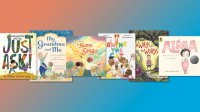Using Picture Books to Make Your Classroom More Welcoming
Picture books can help elementary teachers address sensitive topics such as learning differences and diverse family structures.
Your content has been saved!
Go to My Saved Content.It’s vital that teachers make sure their classrooms are a welcoming place where all students feel safe to be themselves and where learning differences are recognized and respected. Many picture books can light the way for welcoming conversations about names, families, and different ways of learning.
Memorizing students’ names and pronouncing them correctly is an important first step in making your students feel welcome in class. This is personal for me. I have a unique name, and as I was growing up, it presented a lot of challenges. I had many conversations about the fact that yes, my name does not have the letter d in it. My fourth-grade teacher insisted that it did, and my parents had to intervene. So I know firsthand how important it is to get students’ names right.
Books About Respecting Names
There are quite a few books that address the issue of names, and Alma and How She Got Her Name, by Juana Martinez-Neal, is a great one. In this book, the main character learns about all the different relatives she is named after and how it is the practice in their culture to name children after ancestors.
In another excellent picture book about names, Your Name Is a Song, by Jamilah Thompkins-Bigelow, a girl is upset that her teacher continues to stumble over pronouncing her name, so her mom shows her how to sing it. The mom shares the song with the class and sings all of the students’ names. The publisher also provides a video of the author singing all of the names mentioned in the book.
After reading this book, it’s a great time to make sure that everyone’s name is being pronounced correctly. It also creates an opportunity for everyone to share the story of their name and why it was chosen.
Your name is such an important part of your identity. If there is confusion over a name, this can be the time to have a student explain it or practice saying it for classmates. An activity that students could do is write out their names on card stock and decorate the letters and draw pictures around their name that represent what it means.
Books About Family Structure
Another important aspect of students’ lives to address is diverse family units. Students may come from many different family structures. They may live with grandparents, aunts and uncles, or foster families. They should feel comfortable speaking about their home life and who they spend their time with at home.
One book that encourages this type of conversation without being didactic is Bathe the Cat, by Alice B. McGinty. This funny story is about a biracial family consisting of three kids and their two dads who are getting ready for Grandma Marge’s visit. The family’s cat finds their chore list and sees that they want to give her a bath, so she rearranges the list. It’s not mentioned that they are a gay couple, and their relationship is not the crux of the story. But it exposes children to a diverse family.
My Grandma and Me is another picture book that features a diverse family structure. It tells the true story of the upbringing of the author, Mina Javaherbin, who recounts her childhood in Iran, growing up with her grandmother. It incorporates practices of the Muslim faith and showcases the caring and close relationship between the girl and her grandmother. A good post-reading activity would be to have students write and draw about an important person at their home and a favorite activity they do together. If a student doesn’t want to discuss this, they could write about an activity they like to do at home in their free time.
Books About Learning Differences
Teachers can use picture books to address the different ways that people learn and the various strengths that different students have. These books allow teachers to present information about learning disabilities such as auditory processing disorder, dyslexia, dyscalculia, attention deficit disorder, and more.
A wonderful book that addresses reading challenges is A Walk in the Words, by Hudson Talbott. This beautifully illustrated book tells the story of a boy who reads slowly and learns to appreciate that he takes his time with reading. The teacher could then talk about various learning challenges and explain how people with those challenges learn best.
For example, I would share with students that I draw or doodle if I can when someone is speaking or teaching. I would explain that if you saw me, it might look like I wasn’t paying attention because my head would be down and I would be doodling on my paper, but drawing actually helps me to listen and focus.
Another book to read to students about different abilities is Just Ask! Be Different, Be Brave, Be You, by U.S. Supreme Court Justice Sonia Sotomayor. This book talks about how everybody has different strengths and challenges, and everyone needs to accept themselves. A teacher could post a statement such as “I learn well when…” and “It is hard for me to learn or pay attention when…” Students could write down their own answers. If students are able to discuss this and understand each other, it can also bring awareness to themselves and improve learning.
Students spend nine months together, and it benefits them so much to be able to speak openly and comfortably about themselves and their families. When students feel understood and secure, they are better able to learn. Discussing names, families, and learning disabilities or challenges promotes understanding and acceptance and makes for a safer environment for learning.
